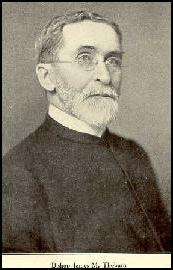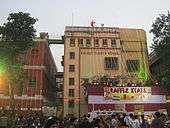Calcutta Boys' School
| The Calcutta Boys' School | |
|---|---|
 Dei Mundus Deo (Latin: The World of God for God) | |
| Address | |
|
72, S.N. Banerjee Road, Kolkata - 700014 Kolkata, West Bengal, India | |
| Information | |
| Established | 1877 |
| Principal | Mr. Raja McGee |
| Number of students | 2200 |
| Classes | Nursery (4+) to 12 (ISC) |
| Website |
www |
The Calcutta Boys' School was founded by the Rev. James Mills Thoburn (Methodist Missionary to India, and later Missionary Bishop of the Methodist Episcopal Church), and was opened in 1877. It was endowed by the late Robert Laidlaw and others interested in the education of the sons of the Anglo-Indian and domiciled European community.[1]
Origins
The origins of CBS are closely linked with the establishment of the Methodist Episcopal Church in India. In January 1873, the Reverend William Taylor founded the work of the Thoburn Methodist Episcopal Church in Calcutta (Kolkata).[1] He was succeeded by the Reverend James Mills Thoburn. The latter's ardent preaching soon rendered the Entally Baptist Chapel unable to cope with the increasing number of converts.[2] In February 1874, a new chapel was opened at 145 Dharamtolla Street, built at a cost of 16,000 rupees largely due to the generosity of George Bowen of Bombay who donated 10,000 rupees.[3] Soon even this chapel proved unable to accommodate the growing congregation, until a larger church was constructed on Dharamtolla Street, where it stands today. The New Thoburn Church was dedicated on 31 December 1875. In 1888 Rev. James Mills Thoburn was elected Missionary Bishop of India and Malaysia - the first ever Missionary Bishop in India.[2]

It was Bishop Thoburn who founded the Calcutta Boys' School. First located at Mott Lane, and then later housed in a room on Corporation Street (known as S. N. Banerjee Road today), the school struggled for survival without a building of its own. It acquired a permanent residence in 1893 thanks to the generosity of a man who could be regarded as the chief patron of the school: Sir Robert Laidlaw
The Girls School was erected in 1886, during the principal-ship of Miss Hendricks.[4]
1930s to present
The school struggled for finances in its early years, and was on the verge of closing down during the Great Depression. It was Principal Horace Christopher Fritchley who then took over the reins and saw the school through the turbulent 1930s and 1940s that saw the Depression, the Second World War, Independence and Partition. He did away with the system of prizes on Sports Day, inculcating the value of love for sport.
Fritchley was succeeded by his son-in-law Clifford Hicks in 1952 until he took voluntary retirement from his position of Principal & Secretary in October 1974).
During Clifford Hicks' time as Principal & Secretary, the newest of the three buildings that currently houses the CBS Chapel Hall was built. Named the Fritchley Building the construction was made possible by the retirement benefit and gratuity of Mr. Horace Christopher Fritchley which he donated to "his very dear CBS" together with donations collected by the students of the school.[1] The school library (now housed in the old dormitory) is named "The Clifford Hicks Memorial Library". The CBS Archives (established in 2008) are also housed in the Library.

During Alfred Martin's tenure the school changed from Senior Cambridge to the ICSE and ISC system affiliated to the Indian Council of Secondary Education. Throughout the 1980s, students ranked prominently in the ICSE and ISC rankings. Unlike the Hicks era, Martin encouraged students to participate in co-curricular activities such as debating and quizzing. The school developed a debating society and a quiz club, which during the 1980s swept most of the inter-school meets. In the early 1980s, the school's Quiz Team of Arpan Guha, Indranuj Chowdhury, Bhaskar Banerjee and Anirvanjyoti Chaudhuri went unchallenged on the inter-school quiz scene in Calcutta - which was at that point the quizzing capital of India under the benign nurture of the great D. O'Brien. During the same period, the school picked up most of the creative writing and western music awards at inter-school fests.
Gilbert Samuel, who became Principal in 1997, furthered the cause of co-curricular activities, allowing the students of CBS to secure top positions at premier National and International contests regularly, including a second-place finish at the 2003 Biology Olympiad and the International Informatics Olympiad in 2004.[5] In 2005 CBS won the under-16 national cricket tournament, and in 2004 the national rounds of the Inter School Frank Antony Memorial Debate.[6]
Houses
The House system was introduced in CBS in 1916. The four houses into which the students are divided on admission to the school are named after those who made the most contribution to the school - Thoburn for red, Warne for gold, Henderson (previously named Pritchard) for blue and Laidlaw for green.


House events are held such as the Lingua Fiesta, the CBS Soccer (Inter-House Football Tournaments), the COSMA and the Annual Athletic Meet in the month of December. The house that emerges victorious at the end of the House competition is awarded a trophy.
Each house is assigned a House Master or Mistress that looks after the activities of that House, and ensures a democratic process of selection and nomination for the offices that are associated with the governing of the house.

Notable alumni
- M.J. Akbar, journalist, national spokesperson of the Bharatiya Janata Party
- Chandrajit Banerjee, Director General - Confederation of Indian Industry
- Sasthi Brata, writer
- Swapan Kumar Chakravorty, Professor of English, Jadavpur University, and former director of National Library of India
- Utpal Chatterjee, cricketer
- Tamoghna Ghosh, politician
- Altamas Kabir, former Chief Justice of India
- Amit Mitra, Finance Minister of West Bengal
- Rudrangshu Mukherjee, Editor, The Telegraph
- Binayak Sen, social worker and paediatrician
- Benjamin Walker, writer
References
- 1 2 3 Clifford Hicks by Alfred Martin, Pulse, Calcutta, February 1980.
- 1 2 "visions & victories in Hindustan" by Bishop B.T. Badley
- ↑ "The Opening Gate 1873-1923" Ed.by Louise Holloway Joyner
- ↑ Cultural and Educational Life in Calcutta
- ↑ The Telegraph, 2 June 2003; 5 June 2004
- ↑ The Telegraph unable to find exact date.